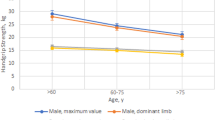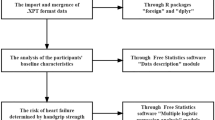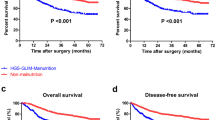Abstract
Background
Handgrip strength (HGS) is a simple yet effective bed-side tool for assessing muscle strength, which plays an important role in clinical evaluation and monitoring. We hypothesize that repeated measurements of HGS during the hospital stay may serve as a reliable and robust indicator of clinical course and outcomes.
Methods
We re-analyzed data from 565 out of 2028 patients who had repeated handgrip measurement (on admission and on day 7) included in EFFORT, a Swiss-wide multicenter, randomized controlled trial comparing individualized nutritional support with usual care nutrition in medical inpatients. The primary endpoint was 180-day all-cause mortality.
Results
The mean change in HGS from baseline to day 7 was 0.6 kg (SD 4.2) in female and 0.7 kg (SD 3.7) in male patients. Patients with a positive HGS trend had a lower risk of dying within 180 days compared to patients without a positive trend (mortality 11.4% vs. 25.4%, adjusted HR 0.45 [95% CI 0.27 to 0.77], p = 0.003). The change in HGS was also associated with the nutritional intake during the hospitalization in male patients: those who met their energy and protein targets were twice as likely to have an increase in HGS during hospitalization (adjusted OR 2.05 [95% CI 1.23 to 3.42], p = 0.006).
Conclusions
Achieving nutritional targets was associated with a short-term increase in HGS during hospitalization, and a positive HGS trend was associated with a lower risk of mortality after 180 days. These data provide evidence that repeated HGS measurements are a robust bedside tool for assessing and monitoring patients receiving nutritional therapy in the hospital.
Trial Registration
ClinicalTrials.gov Identifier: NCT02517476
This is a preview of subscription content, access via your institution
Access options
Subscribe to this journal
Receive 12 print issues and online access
$259.00 per year
only $21.58 per issue
Buy this article
- Purchase on SpringerLink
- Instant access to full article PDF
Prices may be subject to local taxes which are calculated during checkout


Similar content being viewed by others
Data availability
Our data will be made available to others with the publication of this manuscript, as already outlined in the primary EFFORT publication, on receipt of a letter of intention detailing the study hypothesis and statistical analysis plan. A signed data access agreement is required from all applicants. Please send requests to the principal investigator of this trial.
Code availability
Data described in the manuscript, code book, and analytic code will be made available to others with the publication of this manuscript, as already outlined in the primary EFFORT publication, on receipt of a letter of intention detailing the study hypothesis and statistical analysis plan.
References
Felder S, Lechtenboehmer C, Bally M, Fehr R, Deiss M, Faessler L, et al. Association of nutritional risk and adverse medical outcomes across different medical inpatient populations. Nutrition. 2015;31:1385–93.
Khalatbari-Soltani S, Marques-Vidal P. The economic cost of hospital malnutrition in Europe; a narrative review. Clin Nutr ESPEN. 2015;10:e89–e94.
Imoberdorf R, Meier R, Krebs P, Hangartner PJ, Hess B, Staubli M, et al. Prevalence of undernutrition on admission to Swiss hospitals. Clin Nutr. 2010;29:38–41.
Pirlich M, Schutz T, Kemps M, Luhman N, Minko N, Lubke HJ, et al. Social risk factors for hospital malnutrition. Nutrition. 2005;21:295–300.
Schütz P, Bally M, Stanga Z, Keller U. Loss of appetite in acutely ill medical inpatients: physiological response or therapeutic target?. Swiss Med Wkly. 2014;144:w13957.
Casaer MP, Van, den Berghe G. Nutrition in the acute phase of critical illness. N Engl J Med. 2014;370:1227–36.
Norman K, Stobaus N, Gonzalez MC, Schulzke JD, Pirlich M. Hand grip strength: outcome predictor and marker of nutritional status. Clin Nutr. 2011;30:135–42.
Cruz-Jentoft AJ, Bahat G, Bauer J, Boirie Y, Bruyère O, Cederholm T, et al. Sarcopenia: revised European consensus on definition and diagnosis. Age Ageing. 2019;48:16–31.
Cederholm T, Jensen GL, Correia M, Gonzalez MC, Fukushima R, Higashiguchi T, et al. GLIM criteria for the diagnosis of malnutrition - A consensus report from the global clinical nutrition community. Clin Nutr. 2019;38:1–9.
Prado CM, Landi F, Chew STH, Atherton PJ, Molinger J, Ruck T, et al. Advances in muscle health and nutrition: A toolkit for healthcare professionals. Clin Nutr. 2022;41:2244–63.
Deutz NEP, Ashurst I, Ballesteros MD, Bear DE, Cruz-Jentoft AJ, Genton L, et al. The underappreciated role of low muscle mass in the management of malnutrition. J Am Med Dir Assoc. 2019;20:22–7.
Wunderle C, Gomes F, Schuetz P, Stumpf F, Austin P, Ballesteros-Pomar MD, et al. ESPEN Guideline on Nutritional Support for Polymorbid Medical Inpatients. Clin Nutr. 2023;42:1545–68.
Dent E, Morley JE, Cruz-Jentoft AJ, Arai H, Kritchevsky SB, Guralnik J, et al. International Clinical Practice Guidelines for Sarcopenia (ICFSR): Screening, Diagnosis and Management. J Nutr Health Aging. 2018;22:1148–61.
Volkert D, Beck AM, Cederholm T, Cruz-Jentoft A, Goisser S, Hooper L, et al. ESPEN Guideline on Clinical Nutrition and Hydration in Geriatrics. Clin Nutr. 2019;38:10–47.
Humphreys J, de la Maza P, Hirsch S, Barrera G, Gattas V, Bunout D. Muscle strength as a predictor of loss of functional status in hospitalized patients. Nutrition. 2002;18:616–20.
Olguin T, Bunout D, de la Maza MP, Barrera G, Hirsch S. Admission handgrip strength predicts functional decline in hospitalized patients. Clin Nutr ESPEN. 2017;17:28–32.
Kaegi-Braun N, Tribolet P, Baumgartner A, Fehr R, Baechli V, Geiser M, et al. Value of handgrip strength to predict clinical outcomes and therapeutic response in malnourished medical inpatients: Secondary analysis of a randomized controlled trial. Am J Clin Nutr. 2021;114:731–40.
Wunderle C, Gomes F, Schuetz P, Stumpf F, Austin P, Ballesteros-Pomar MD, et al. ESPEN practical guideline: Nutritional support for polymorbid medical inpatients. Clin Nutr. 2024;43:674–91.
Graf C. Functional decline in hospitalized older adults. Am J Nurs. 2006;106:58–67.
Allard JP, Keller H, Teterina A, Jeejeebhoy KN, Laporte M, Duerksen DR, et al. Lower handgrip strength at discharge from acute care hospitals is associated with 30-day readmission: A prospective cohort study. Clin Nutr. 2016;35:1535–42.
Werle S, Goldhahn J, Drerup S, Simmen BR, Sprott H, Herren DB. Age- and gender-specific normative data of grip and pinch strength in a healthy adult Swiss population. J Hand Surg Eur Vol. 2009;34:76–84.
Amaral CA, Amaral TLM, Monteiro GTR, Vasconcellos MTL, Portela MC. Hand grip strength: Reference values for adults and elderly people of Rio Branco, Acre, Brazil. PLoS One. 2019;14:e0211452.
Steiber N. Strong or Weak Handgrip? Normative Reference Values for the German Population across the Life Course Stratified by Sex, Age, and Body Height. PLoS One. 2016;11:e0163917.
Schuetz P, Fehr R, Baechli V, Geiser M, Gomes F, Kutz A, et al. Design and rationale of the effect of early nutritional therapy on frailty, functional outcomes and recovery of malnourished medical inpatients trial (EFFORT): a pragmatic, multicenter, randomized-controlled trial. Int J Clin trials. 2018;9:1–9.
Schuetz P Effect of Early Nutritional Therapy on Frailty, Functional Outcomes and Recovery of Undernourished Medical Inpatients Trial (EFFORT) 2014 [cited 2016 20. November 2016]. Available from: https://clinicaltrials.gov/ct2/show/NCT02517476.
https://www.ncmedical.com/item_699.html (latest access: 29/042020).
Hillman TE, Nunes QM, Hornby ST, Stanga Z, Neal KR, Rowlands BJ, et al. A practical posture for hand grip dynamometry in the clinical setting. Clin Nutr. 2005;24:224–8.
Kondrup J, Rasmussen HH, Hamberg O, Stanga Z, Ad Hoc EWG. Nutritional risk screening (NRS 2002): a new method based on an analysis of controlled clinical trials. Clin Nutr. 2003;22:321–36.
Bounoure L, Gomes F, Stanga Z, Keller U, Meier R, Ballmer P, et al. Detection and treatment of medical inpatients with or at-risk of malnutrition: Suggested procedures based on validated guidelines. Nutrition. 2016;32:790–8.
Gomes F, Schuetz P, Bounoure L, Austin P, Ballesteros-Pomar M, Cederholm T, et al. ESPEN guidelines on nutritional support for polymorbid internal medicine patients. Clin Nutr. 2018;37:336–53.
Matheson EM, Nelson JL, Baggs GE, Luo M, Deutz NE. Specialized oral nutritional supplement (ONS) improves handgrip strength in hospitalized, malnourished older patients with cardiovascular and pulmonary disease: A randomized clinical trial. Clin Nutr. 2021;40:844–9.
Rijk JM, Roos PR, Deckx L, van den Akker M, Buntinx F. Prognostic value of handgrip strength in people aged 60 years and older: A systematic review and meta-analysis. Geriatr Gerontol Int. 2016;16:5–20.
McGrath R, Johnson N, Klawitter L, Mahoney S, Trautman K, Carlson C, et al. What are the association patterns between handgrip strength and adverse health conditions? A topical review. SAGE Open. Medicine. 2020;8:2050312120910358.
Leong DP, Teo KK, Rangarajan S, Lopez-Jaramillo P, Avezum A Jr., Orlandini A, et al. Prognostic value of grip strength: findings from the Prospective Urban Rural Epidemiology (PURE) study. Lancet. 2015;386:266–73.
Sasaki H, Kasagi F, Yamada M, Fujita S. Grip strength predicts cause-specific mortality in middle-aged and elderly persons. Am J Med. 2007;120:337–42.
Bo Y, Liu C, Ji Z, Yang R, An Q, Zhang X, et al. A high whey protein, vitamin D and E supplement preserves muscle mass, strength, and quality of life in sarcopenic older adults: A double-blind randomized controlled trial. Clin Nutr. 2019;38:159–64.
Nunes EA, Colenso-Semple L, McKellar SR, Yau T, Ali MU, Fitzpatrick-Lewis D, et al. Systematic review and meta-analysis of protein intake to support muscle mass and function in healthy adults. J Cachexia Sarcopenia Muscle. 2022;13:795–810.
Liu M, Liu S, Sun S, Tian H, Li S, Wu Y. Sex differences in the associations of handgrip strength and asymmetry with multimorbidity: evidence from the english longitudinal study of ageing. J Am Med Dir Assoc. 2022;23:493–8.e1.
Wright J, Baldwin C. Oral nutritional support with or without exercise in the management of malnutrition in nutritionally vulnerable older people: A systematic review and meta-analysis. Clin Nutr. 2018;37:1879–91.
Acknowledgements
We thank all participating patients and the entire EFFORT Team as well as all other hospital staff for their support.
Funding
The original EFFORT trial and this sub-analysis were funded by the Research Council of the Kantonsspital Aarau (1410.000.058 and 1410.000.044) and by grants from the Swiss National Science Foundation (SNSF) (PP00P3_150531 and PP00P3_176972).
Author information
Authors and Affiliations
Contributions
Pascal Tribolet: Conceptualization, data collection, formal analysis, visualization, writing – original draft, writing – review & editing. Carla Wunderle: Conceptualization, formal analysis, investigation, writing – original draft, writing – review & editing. Nina Kaegi-Braun: Conceptualization, formal analysis, investigation, writing – review & editing. Lena Buchmueller: Visualization, writing – original draft, writing – review & editing. Rahel Laager: Formal analysis, Visualization, writing – review & editing. Zeno Stanga: Funding acquisition, investigation, writing – review & editing. Beat Mueller: Funding acquisition, investigation, writing – review & editing. Karl-Heinz Wagner: Investigation, writing – review & editing. Philipp Schuetz: Conceptualization, funding acquisition, investigation, project administration, writing – review & editing.
Corresponding author
Ethics declarations
Ethical approval
The study protocol was approved by the Ethics Committee of Northwest and Central Switzerland (EKNZ; 2014_001). All participants provided their written informed consent to participate in this study. The trial was registered at ClinicalTrials.gov (https://clinicaltrials.gov/ct2/show/NCT02517476). All methods were performed in accordance with the relevant guidelines and regulations.
Competing interests
The Institution of P. Schuetz has previously received unrestricted grant money unrelated to this project from Nestlé Health Science and Abbott Nutrition. The institution of Z. Stanga received speaking honoraria and research support from Nestlé Health Science, Abbott Nutrition, and Fresenius Kabi. All other authors report no conflicts of interest. The results presented in this paper have not been published previously in whole or part, except in abstract form.
Additional information
Publisher’s note Springer Nature remains neutral with regard to jurisdictional claims in published maps and institutional affiliations.
Supplementary information
Rights and permissions
Springer Nature or its licensor (e.g. a society or other partner) holds exclusive rights to this article under a publishing agreement with the author(s) or other rightsholder(s); author self-archiving of the accepted manuscript version of this article is solely governed by the terms of such publishing agreement and applicable law.
About this article
Cite this article
Tribolet, P., Wunderle, C., Kaegi-Braun, N. et al. Evaluating repeated handgrip strength measurements as predictors of mortality in malnourished hospitalized patients. Secondary analysis of a randomized controlled trial. Eur J Clin Nutr 79, 897–903 (2025). https://doi.org/10.1038/s41430-025-01618-w
Received:
Revised:
Accepted:
Published:
Issue date:
DOI: https://doi.org/10.1038/s41430-025-01618-w



